Looking at the choice between current and coming electric cars
We have owned electric cars since 2011. My wife and I loved our 2011 Nissan Leaf and now love our 2016 Chevrolet Volt. We were our dealer’s first delivery of a LEAF and our dealer’s first delivery of the 2016 Volt. Now that there are choices with over 200-mile range, we’re tempted to order either the new Tesla Model 3 or the Chevrolet Bolt.
Option 1: 2018 Tesla Model 3
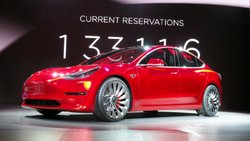
In the first 24 hours, 180,000 people made refundable deposits of $1,000 to reserve the new Tesla Model 3. Within a few days there were more than 325,000 reservations and the list continues to grow. Reserve one today and you will likely wait three years for delivery. For many, the wait will be worth it. For others, there are other excellent electric car choices that may better meet needs: driving range, cargo needs, whether you have two cars or one, and whether you can plug-in the car daily.
The Tesla Model 3 has a base price of $35,000 for an electric car with 215 mile-range, yet retains many of the features of an $80,000 Model S. The new Model 3 will be a compact sedan about the size of a BMW 3-Series instead of the 20 percent larger Model S, which is closer to the size of a BMW 7-Series.
I deliberately call the car a 2018 Tesla Model 3, because you won’t get one in 2017. You can reserve the car now, get more details soon, and test drive some day. Although first delivers of the Tesla 3 are targeted for late 2017, there are 300,000 people ahead of you and Tesla has a history of being late with new models. Delivery priorities likely will be existing Tesla owners, more expensive models, and then your queue location.
Today, Tesla has more 3,600 Superchargers and more than 3,600 destination chargers, allowing owners to fully charge in 30 to 60 minutes for free. Many are located near restaurants and Starbucks. By the time you get delivery of the Model 3, Tesla will triple its Supercharger locations. Tesla altered its description of the Model 3’s Supercharger connection from initially describing it as having access to the network to being capable of access to the network, which looks like Model 3 owners may find that coming as an upcharge on the base price. Like other EVs, Tesla 3s can also use the tens of thousands of Level 2 chargers at employers, many parking lots and public spaces. Using apps like Google Maps or Plug Share, they are easy to find.
Starting at $35,000, the Tesla Model 3 will come standard with Supercharging capability and Autopilot self-driving technology, according to Elon Musk. Some consider Tesla to have the safest cars on the road. Musk initially assured that the Model 3 will have 5-star safety ratings in every category, but then changed that promise being “designed to achieve†that rating, a much safer promise for a car still two years from production.
The Tax Break–That May Not Be There
Just as I have received $7,500 off my taxes for buying an electric car, you have the potential to bring your Tesla cost down to $27,500 and lower in the many states that add incentives. Six months after an automaker has a cumulative 200,000 customers claim tax credits, the credits phase out. FYI, Tesla hit 100,000 units of global sales (most in the U.S.) in December 2015 and aims to ramp up Model X production during 2016, though first quarter deliveries were below expectations. By the time you can get delivery of the Model 3, the Tesla credits will likely be gone.
Although Tesla has provided few details about the Model 3, industry speculation is extensive:
- There will be several versions of the Model 3.
- The base model will have a battery about 50 percent bigger than the Nissan Leaf, but perhaps half the 90 kWh of the high-end Model S versions.
- Being smaller and lighter, the 215-mile range will be achievable under many driving conditions. Like all electric cars, range will be reduced by driving speed, hills and cold weather.
Do you have a place at home or work to plug-in your vehicle? My former condo neighbor returned from a two-week trip to find her Tesla’s battery pack permanently dead. She had failed to leave the Tesla plugged in, which is recommended to keep the battery pack’s thousands of cells balanced. In my years of owning a Nissan Leaf and a Chevrolet Volt, I have been able to leave the cars unplugged for three weeks, and then start them with no hassle. Like most modern EVs, they use large-form automotive lithium cells.
In the months ahead, Tesla needs to provide detailed specs for charging the Model 3. If you don’t have regular access to an electric outlet, discuss the issue with Tesla, and get the answer in writing. For you, a Bolt, Volt, Leaf or even a Prius may be better choices.
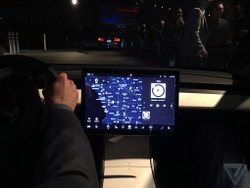
I wouldn’t be surprised to see a pricey version of the Model 3 with a 300-mile range, besting the 270-mile Model S. More expensive versions of the Model 3 are also likely to include AWD, advanced safety features, valet parking, premium interior and exterior, much like was shown on the demo models shown at the reveal.
The Tesla Model 3 is likely to be an amazing car for $35,000, even if tax incentives are gone. Many buyers are likely to pay $40,000 to $60,000 to get the range and options that they desire.
Even if you don’t order a Tesla, you have to admire their innovation. Continually updating software, including Autopilot, makes their cars safer and better. Many of their owners charge with solar energy, some with grid power, but none with petroleum (assuming they aren’t using diesel generators for their electricity). More than 300,000 deposits for the new Model 3 is a wake-up call to every executive at GM, Toyota, Ford, VW and the rest.
Option 2: 2017 Chevrolet Bolt
With a 200-mile minimum electric range, the new Chevrolet Bolt has almost identical range to the entry level Tesla 3. The Bolt will have a 60 kWh battery pack. The Bolt has a base price of
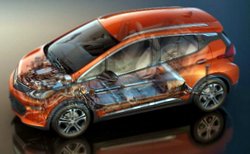
$37,500. If you order one later this year, you are likely to take delivery of the Bolt two years sooner than the Tesla 3.
The Bolt is a stylish crossover, similar to a sport SUV. With a liftback, you should be able to lower the back seats and put a couple of bicycles inside as I do in my Volt. With Tesla you would likely need a third-party bike rack. But with both front and rear trunks, the Tesla 3 will meet most cargo needs.
GM has sold more than 90,000 plug-in vehicles at this point, so, if you order a Bolt, you would likely have a good chance to receive a $7,500 IRS credit, making the entry Bolt at least $5,000 less expensive than the Tesla 3 after federal and state incentives.
I paid an extra $5,000 for the advanced driver safety (ADAS) features in our Chevrolet Volt, which uses radar and two high-resolution cameras to give us a back-up camera, lane keep assist, forward collision and pedestrian alerts with automatic braking, and side blind spot alerts. The new Bolt will be even better with four cameras to support all those safety features plus 360-degree surround vision. While the new Bolt will lack Tesla’s self-driving abilities, it will be impressively safe.
Charging on the Level
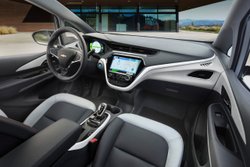
Tesla’s network of Superchargers will be greater than the network of DC fast chargers available for Bolts (DC fast charge may be optional; that hasn’t been announced), but tens of thousands of Level 2 chargers at employers, parking lots and public spaces are available for all plug-in vehicles. Both Tesla and Chevrolet are claiming a range increase of 25 miles for each hour of Level 2 charging, much faster than I see with my 2016 Volt.
Tesla also has the advantage with over-the-air software updates; just as the apps on your phone update themselves, a Tesla network updates automatically to keep getting smarter and better. With my Chevrolet, I have been promised Android Auto for a year, yet every time I call the dealer to make an appointment to upgrade, they are still waiting for a DVD from the factory.
When you finally get a chance to test drive both the Chevrolet Bolt and the Tesla Model 3, you may decide that you prefer the Tesla 15-inch touchscreen and drive-by-wire, or you may prefer the Bolt’s 10-inch touchscreen and traditional instrument panel. You are likely to prefer both over your present car and most alternatives on the market.
Although Tesla has a head start of more than 300,000 reservations, Chevrolet dealers should start delivering the Bolt a year sooner than the first Tesla 3 and two years sooner than most since GM has a long track record of mass-producing vehicles, something that still presents Tesla with a steep learning curve.
Option 3: Get a Plug-in Electric Today
The Nissan Leaf and the Chevrolet Volt are the two best selling electric cars starting below $35,000 with deliveries today.
With our 2016 Chevrolet Volt, we have driven more than its rated 53-mile electric range. When driving locally, we fill-up less than once a month. We have driven 500 miles to see family without worrying about finding charging spots, because the Volt is a plug-in hybrid that also includes a nine-gallon gas tank to give us 420-mile total range.
Some friends are surprised that we sold our electric Nissan Leaf and replaced it with a Volt plug-in hybrid. We are no longer driving pure electric and feel a bit guilty when adding gasoline. Although we experienced occasional range anxiety, my wife and I drove the Leaf for three and a half years without ever running empty.
We switched to the Volt because we went from two cars to one. In fact, we now have one Volt and two electric bicycles. Living in San Francisco, it all works. We can walk to grocery stores and restaurants. If the walk is too long, we can bike or take nearby transit. If we are in a hurry, Uber and Lyft are omnipresent.
If you need one car to meet all your needs, including a fair amount of long distance, you might prefer a plug-in hybrid like the Chevrolet Volt. If you have no place to charge, the Toyota Prius or one of the other 36 non plug-in hybrids might be even better.
Leaf/Volt Experience
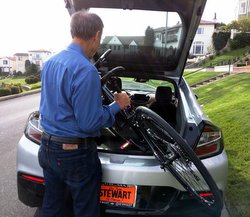
The Leaf worked beautifully during the three-and-a-half years that we drove it. We purchased the Leaf for $33,000, took advantage of tax credits, and sold it on Craigslist (in four days) for $12,700. Ownership cost us $225 per month, plus an average of $35 monthly to keep it charged.
The 2016 Nissan Leaf starts at $29,000 for a complete electric car with the same 24-kWh battery that served us well for 3.5 years. For $34,200, you can now get the Leaf SV with a 32-kWh battery for a 107-mile range. On a flat road driving 40 mph, you might go 140 miles; on a freeway with heater and headlights on, you might have a range of 80 miles. For most, especially those with work and public space charging, this is more than enough range.
What we learned is that if you share two cars, one can be electric with far less range than offered from Tesla and the Bolt. If you are in a household with two or more vehicles, you can be driving great electric cars today.
You can now order plug-in cars from almost all automakers. There are some interesting choices from Audi, BMW, Fiat, Ford, Hyundai, Toyota, VW and others. We’ve reviewed most of them on this site. Tesla, Nissan and Chevrolet are the sales leaders. Customers evaluate, test drive, and make good choices in all-electric and plug-in hybrids.
You may want to eagerly await a beautifully designed 200-mile electric range cars like the Tesla Model 3 or Chevrolet Bolt. Speaking as a five-year plug-in car driver, do not forget to consider the practical issues like your driving range, cargo needs, whether you have two cars or one, and whether you have a place to charge the electric car. For many, the Chevrolet Volt and Nissan Leaf and their counterparts are ideal, affordable, and you can drive one today.
More than one million electric cars have been sold worldwide in the past five years and a third of them are in the U.S. With one announcement, another 300,000 have lined-up to get outstanding performance, styling and safety. Electric cars have an enormous future. Are you in?
Related Stories You Might Enjoy:
Chevrolet Bolt Specs Revealed
John Replaces His Nissan Leaf with a Chevrolet Volt
Best-Selling Electric Cars in the U.S.

11 thoughts on “Buyer’s Guide: Tesla Model 3, Chevrolet Bolt or 2016 EV?”